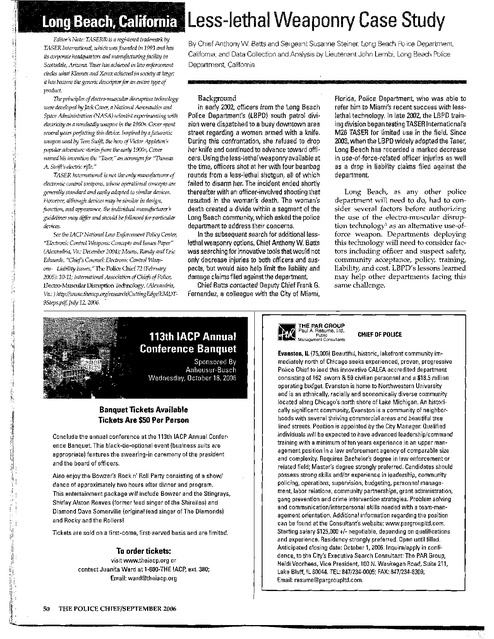Taser Police Chief Mag Long Beach Ca Less-lethal Weaponry Case Study 2006
Download original document:

Document text

Document text
This text is machine-read, and may contain errors. Check the original document to verify accuracy.
long Beael'J, California Editor's Note: TASER® is a registered trademark by TASER International, which was founded in 1993 and has its corporate headquarters and manufacturingfacility in Scottsdale, Arizona. Taser has achieved in law enforcement circles what Kleenex and Xerox achieved in society at large: it has become the generic descriptorfor an entire type of product. The principles ofelectro-muscular disruption technology were developed by Jack Caver, aNational Aeronautics and Space Administration (NASA) scientist experimenting with electricity as anondeadly weapon in the 1960s. Cover spent several years perfecting this device. Inspired by afuturistic weapon used by Tom Swift, the hero ofVictor Appleton's popular adventure stories from the early 1900s, Cover named his invention the "Taser," an acronymfor "Thomas A. Swift's electric rifle." TASER International is not the only manufacturer of electronic control weapons, whose operational concepts are generally standard and easily adapted to similar devices. However, although devices may be similar in design, function, and appearance, the individual manufacturer's guidelines may differ and should be followed for particular devices. See the IACP National Law Enforcement Policy Center, "Electronic Control Weapons: Concepts and Issues Paper" (Alexandria, Va.: December 2004); Means, Randy and Eric Edwards, "Chief's Counsel: Electronic Control Weapons-Liability Issues,"'Ibe Police Chief 72 (February 2005): 10-11; International Association ofChiefs ofPolice, Electro-Muscular Disruption Technology, (Alexandria, Va.: ) http://www.theiacp.org/research/CuttingEdge/EMDT9Steps.pdJ, July 12, 2006. • Less-lethal Weaponry Case Study By Chief Anthony W. Batts and Sergeant Susanne Steiner, Long Beach Police Department, California, and Data Collection and Analysis by Lieutenant John Lembi, Long Beach Police Department, California Background In early 2002, officers from the Long Beach Police Department's (lBPD) south patrol division were dispatched to a busy downtown area street regarding a woman armed with a knife. During this confrontation, she refused to drop her knife and continued to advance toward officers. Using the less-lethal weaponry available at the time, officers shot at her with four beanbag rounds from a less-lethal shotgun, all of which failed to disarm her. The incident ended shortly thereafter with an officer-involved shooting that resulted in the woman's death. The woman's death created a divide within a segment of the Long Beach community, which asked the police departmentto address their concerns. In the subsequent search for additional lesslethal weaponry options, Chief Anthony W. Batts was searching for innovative tools that would not only decrease injuries to both officers and suspects, but would also help limit the liability and damage claims filed against the department. Chief Batts contacted Deputy Chie'f Frank G. Fernandez, a colleague with the City of Miami, Florida, Police Department, who was able to refer him to Miami's recent success with lesslethal technology. In late 2002, the lBPD training division begantesting TASER International's M26 TASER for limited use in the field. Since 2003, when the LBPD widely adopted the Taser, Long Beach has recorded a marked decrease in use-of-force-related officer injuries as well as a drop in liability claims filed against the department. Long Beach, as any other police department will need to do, had to consider several factors before authorizing the use of the electro-muscular disruption technologyl as an alternative use-afforce weapon. Departments deploying this technology will need to consider factors including officer and suspect safety, community acceptance, policy, training, liability, and cost. LBPD's lessons learned may help other departments facing this same challenge. Iel a - Banquet Tickets Available Tickets Are $50 Per Person Conclude the annual conference atthe 113th IACP Annual Conference Banquet This black-tie-optional event (business suits are appropriate) features the swearing-in ceremony of the president and the board of officers. Also enjoy the Bowzer's Rock n' Roll Party consisting of a show/ dance of approximately two hours after dinner and program. This entertainment package will include Bowzer and the Stingrays, Shirley Alston Reeves (former lead singer of the Shirelles) and Diamond Dave Somerville (original lead singer of The Diamonds) and Rocky and the Rollers! :.i,!'i it:I',i 'TIckets are sold on a first-come, first-served basis and are limited. To order tickets: visit www.theiacp.org or contact Juanita Ward at 1-800-THE IACP, ext. 380; Email: ward©theiacp.org 50 THE POLICE CHIEF/SEPTEMBER 2006 ~ , ~ l THE PAR GROUP Paul A. Reaume, Ltd. Public Management Consultants CHIEF OF POLICE Evanston, IL (75,000) Beautiful, historic, lakefront community immediately north of Chicago seeks experienced, proven, progressive Police Chief to lead this innovative CALEA accredited department consisting of 162 sworn & 59 civilian personnel and a$18.5 million operating budget. Evanston is home to Northwestern University and is an ethnically, racially and economically diverse community located along Chicago's north shore of Lake Michigan. An historically significant community, Evanston is a community of neighborhoods with several thriving commercial areas and beautiful tree lined streets. Position is appointed by the City Manager. Qualified individuals will be expected to have advanced leadership/command training with a minimum often years experience in an upper management position in a law enforcement agency of comparable size and complexity. Requires Bachelor's degree in law enforcement or related field; Master's degree strongly preferred. Candidates should possess strong skills and/or experience in leadership, community policing, operations, supervision, budgeting, personnel management, labor relations, community partnerships, grant administration, gang prevention and crime intervention strategies. Problem solving and communication/interpersonal skills needed with a team-management orientation. Additional information regarding the position can be found atthe Consultant's website: www.pargroupltd.com. Starting salary $125,000 +/- negotiable, depending on qualifications and experience. Residency strongly preferred. Open until filled. Anticipated closing date: October 1, 2006. Inquire/apply in confidence, to the City's Executive Search Consultant: The PAR Group, Heidi Voorhees, Vice President, 100 N. Waukegan Road, Suite 211, Lake Bluff, IL 60044. TEL: 847/234-0005; FAX: 847/234-8309; Email: resume@pargroupltd.com. Deployment Original Taser deployment in 2002 was limited. At first, the Taser was assigned to field sergeants' patrol vehicles, SWAT personnel, and the advanced officer training instructors. Its use proved so valuable that additional Taser units were purchased and distributed for further testing in the patrol arena. Select officers were assigned the Taser as a personal weapon so they did not have to wait for a patrol sergeant to arrive on scene. In 2003, the department purchased the X26 TASER, which was not only smaller, but also more effective due to adjusted wattage and pulse capabilities. The department upgraded its entire cache to the newer model and distributed the Taser to as many officers as there were weapons available. As of 2006, approximately 900 Tasers are issued throughout the patrol bureau, gang enforcement section, detective bureau, motor division, and SWAT. To preserve the Taser's field availability, the training division maintains a small surplus to temporarily replace those units that need repair. The manufacturer trained and qualified training division personnel in routine weapon maintenance, part replacement, and general repairs so the units can be refurbished on site. Additional digital power magazines (batteries) and dart cartridges are also maintained to ensure weapon availability, Policy Considerations The Taser is considered a less-lethal weapon, and its deployment falls within the department's use-of-force paradigm. Officers are authorized to deploy the weapon when suspects have made credible threats to harm themselves, others, or officers. Other authorized uses include defending against aggressive actions by a suspect, in riot or unlawful assemblies, during incidents of active resistance, or when it may be necessary to subdue an attacking animal. Unless reasonable alternatives would pose a greater safety risk to the subject and / or the officer, officers will not use the Taser against handcuffed prisoners, pregnant females, pre-teen children, the elderl)j or the physically disabled. Because the Taser is designed to temporarily incapacitate by making the muscle tissue uncontrollably contract, officers are encouraged to target major muscle groups such as the back or legs, avoiding the head and neck. Each successful Taser deployment, whether a dart or direct contact stun, requires a medical evaluation by emergency room personnel before booking the suspect. In addition to ensuring the suspect receives mandatory medical treatment, the officer who deployed the Taser must complete a use-of-force report. The field supervisor also files a summary report and notifies necessary officials. Once written, the reports are reviewed by several different command levels, including internal affairs, to ensure officers' policies and training needs remain current, practical, and met. If the review process reveals issues of concern, department-wide training is instituted to ensure officers are well informed and proficient with the changes and/or clarifications. Debatable deployments are reviewed so that policy changes, retraining, or disciplinary concerns are quickly and consistently addressed if necessary. Training Currentl)j the department has two expert lead instructors as well as several other qualified co-instructors. Each officer undergoes 10 hours of hands-on training when issued the weapon for field use. Re-certification occurs every ye~ at which time the Tasers are cleaned, tested, and downloaded to ensure the time-stamping mechanism and deployment records are accurate.2 Officer training and re-certification include simulated scenarios as well as written exam questions at the end of each class. Benefits Since the department-wide Taser distribution took place in 2003, the Taser has GET THAT CONFESSION! Since 1959, YOU have had us train your future polygraphists. We teach in 7 weeks proven polygraph procedures as well as how to obtain court-admissible confessions! Knowing budget limitations, tuition remains only $4,376 - the same since spring 2002 ! 9/11 to 10/27/06 Waterbury, Connecticut Chief Neil O'Leary is one of our grads! For free info about our nationally-recognized Expert Law-Enforcement Polygraphist Course, fax your request to 973: 838 - 8661 (24-hour). Richard O. Arther, Director Catherine A. Arther, Co-Ordinator 200 West 57th St.; New York NY 10019-3211 800: 643 - 6597 Circle no. 5 on Reader Response Card THE POLICE CHIEF/SEPTEMBER 2006 51 Electro-Muscular Disruption Technology: A Nine-Step Strategy for Bfective Deployment The International Association of Chiefs of Police, supported by the National Institute of Justice, Office of Justice Programs, U.S. Department of Justice and in collaboration with the Montgomery County, Maryland, Police Department. developed an executive brief to inform law enforcement leadership on the deployment challenges surrounding the EfVlDT technology. This executive brief offers a step-by-step guide to aid law enforcement agencies in selecting, acquiring and using EfVlDT The brief focuses on managing the technology to help leaders develop policies, procedures, and training curricula that are responsive and relevant to the needs of their departments and communities. To obtain a copy of the executive brief, contact the International Association of Chiefs of Police, 515 N. Washington Street. Alexandria, VA 22314; SOD-THE IACP; or visit the IACP web site at http://VvWN.theiacp. org/research/CuttingEdge/EMDT9Steps.pdf become the most frequently used tool when compared to arrest control techniques and other impact weapons. Using data from June 2003 through June 2005, the other use-offorce options experienced a decline in usage ranging from 27 percent to 63 percent. The impact batons accounted for the smallest drop, while. the largest reduction occurred with pepper spray. Because officers would not deploy a Taser against a suspect armed with a gun, there was no change in the officer-involved shooting category. Inspite ofa 2percentincrease in arrests and an 8 percent increase in overall uses of forc;e during the same time period, arrest-related officer injuries decreased 25 percent. The significant drop in officer injuries, however, did not carry over to the suspects, whose injuries actually rose 10 percent. The data revealed that the officers inconsistently reported "redness" as an injury rather than a non-injury, which potentially skewed the numbers. Of the 284 instances where the Taser was deployed between June 2004 and June 2005, only three cases involved serious injuries, while 19 involved moderate injuries. In all three cases involving serious injuries, the injuries were caused by something other than the Taser, and none of the injuries led to death. In most of the 19 cases where moderate injuries were incurred, the injuries were also caused by something other than the Taser. Injuries attributed to the Taser included abrasions and lacerations routinely caused by the fall to the ground after the subject loses muscle control. Due in part to the constant review of policies and procedures, there have been no deaths associated with the use of the Taser. Effectiveness Of the 284 Taser deployments, 219 were dart cartridge discharges while 65 were direct skin or clothing contact "drive stuns." 221 incidents were effective (78 percent), and the suspect was taken into custody without further incident. The 63 ineffective deployments related to the distance at which the Taser was fired, thick or impenetrable clothing worn by the suspect, or both darts not striking the suspect for the connectivity of the charge, and other similar factors. Because the Taser is less invasive than other force options-suchas the impact baton or carotid restraint hold-the department anticipated fewer damage claims against the department and internal affairs complaints. This is, in fact, the case. liability claims filed against the police department fell 33 percent, while internal affairs complaints dropped 9 percent. Although difficult to quantify, anecdotal reports indicate officers' morale improved with the Taser distribution. Good officer tactics dictate distance as a critical safety factor. Generally speaking, many officers and combative subjects incur injuries when the distance is eliminated and the officer is forced to go hands on with the aggressive subject. The Taser essentially creates a 21-foot safety zone for the officer in which to gain INSTITUTE OF CRIMINOLOGY Applied Criminology & Police Management One-year Part-time Diploma One-year Part-time Master's Degree • • • • • • :1 • For senior Police staff & officers of Inspector I Lieutenant rank & above • Formal qualifications not required: aptitude and motivation essential • 3 residential 2-week courses in Cambridge, U.K. each year Vocational, topical and stimulating Builds on core competences and helps equip for promotion Many former students promoted to the most senior ranks Professional and supportive tutors with National Police College experience Engagement with other CJS professionals on other programmes Collegiate membership of the University of Cambridge Next programme starts in Spring 2007 , Tel: Fax: Email: Web: i Ii:! i'I·1 UNIVERSITY OF :1.::; ; CAMBRIDGE II, i~I' ,I}!., I~i Circle no. 36 on Reader Response Card I Ii: li,!i..... IL. · +441223335373 +44 1223335356 police.enquiries@crim.cam.ac.uk www.crim.cam.ac.uklcourses/police 52 Circle no. 22 on Reader Response Card THE POLICE CHIEF/SEPTEMBER 2006 ----- _ the subject's compliance. Officers immediately acknowledged the Taser's usefulness and recognized the benefit to themselves, the subjects they touch, and the community members who may witness the altercation. Recommendations I I More and more police departments will probably undertake deploying some form of electronic control weapon. Reflecting on the LBPD's experience, any department considering deploying this technology should consider the following: • Create a searchable, computerized database to compare, cross-reference, and analyze Taser deployments within the scope of all use-of-force options. Include the following categories • Type of deployment (dart cartridge discharge or direct contact stun) • Each deployment's effectiveness • Injuries to both officers and subjects caused specifically by Taser use • How often the Taser is the only response to a combative subject versus how many times it is used in conjunction with other use-of-force options • Number of cycles used for each deployment • What effect Taser deployment has Circle no. 4 on Reader Response Card had on excessive force complaints and liability claims filed against the department • When writing a deployment poliC)j clarify who the Taser should and should not be used against, in order to help avoid the potentialfor death or serious injury to subjects incapable of withstandingthestun • Discuss the type of clothing the subject is wearing to ensure the pulse of the darts can penetrate the garments • Perform a daily spark test (with the dart cartridge removed) to keep the digital power magazine sufficiently charged for immediate field use. The spark test will also alert officers about any maintenance issues • Because the Taser may be used more frequently than other use-of-force options, conduct periodic refresher training for the force options used less frequently • Educate officers on the civilian Taser model (X26c) and its stun capabilities. Although the civilian model's wattage is less than the law enforcement model's, the stun cycle's timing increases from five to 30 second The LBPD's Taser success has allowed the department to enhance professional See us at IACP booth #2852 service to Long Beach residents while giving officers better options for solving problems, preventing injuries, and ensuring safety. Because the community and media focus on law enforcement tactics and liability, the Long Beach Police Department will continue to search for innovative ways to positively impact our community. •:. 1 Electro-muscular disruption technology (EMDT) uses pulses of electricity to incapacitate suspects. The weapons are designed to deliver up to a 50,000 volt charge with low power and can incapacitate at a distance. Two metal probes connected by thin insulated wires are propelled by either gunpowder or nitrogen gas into the targeted suspect. Once the connection is made, electrical pulses are conducted through the wires for a number of seconds. The electric pulse delivered by EMDT incapacitates suspects by causing the muscles to contract, resulting in the loss of body control. International Association of Chiefs of Police, Electro-Muscular Disruption Technology, (Alexandria, Va.:): 6 http://www.theiacp.org/research/ CuttingEdge/EMDT9Steps.pdf, July 12, 2006. 2 According to TASER International, the TASER X26 stores time, date, duration, temperature, and energy cell status of over 1,500 firings. Data accessed through USB into encrypted secure x 26/1 file format on Windows® PC (Windows® 2000, XP, or ME). http:// www.taser.com./facts/qa.htm. July 12, 2006. /I. Circle no. 18 on Reader Response Card THE POLICE CHIEF/SEPTEMBER 2006 53





